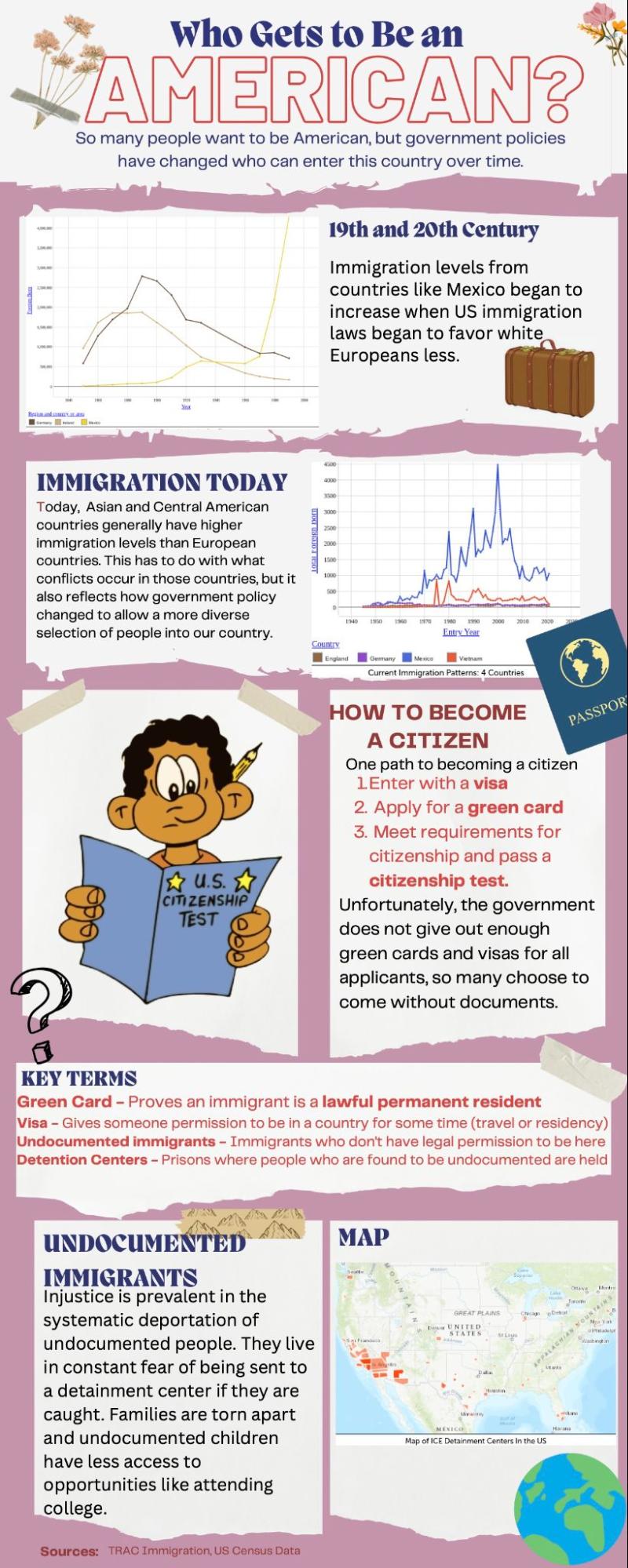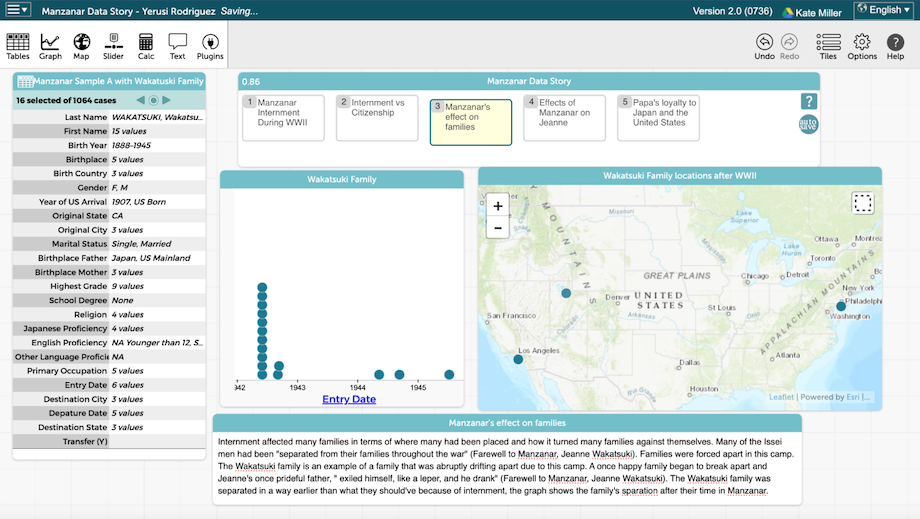Middle school social studies students typically study 20th century immigration, including the push and pull factors that guided immigration and the policies that shaped travel to (and from) the United States. Additionally, Jeanne Wakatsuki Houston’s memoir Farewell to Manzanar, which details her experience in a Japanese American internment camp during World War II, is a popular pick for middle school English Language Arts (ELA) classes. The book provides an ideal opportunity for interdisciplinary exploration of immigrant experiences in the United States.

View of original entrance to Manzanar internment camp, November 2024. Original photograph by Allan J. Cronin. CC BY-SA 4.0.
According to the College, Career, and Civic Life (C3) Framework for Social Studies State Standards (pdf), by the end of Grade 8 students should be able to:
- Analyze connections among events and developments in broader historical contexts.
- Use questions generated about individuals and groups to analyze why they, and the developments they shaped, are seen as historically significant.
- Analyze multiple factors that influenced the perspectives of people during different historical eras.
- Describe the roles of political, civil, and economic organizations in shaping people’s lives.
- Analyze the purposes, implementation, and consequences of public policies in multiple settings.
- Compare historical and contemporary means of changing societies and promoting the common good.
- Classify series of historical events and developments as examples of change and/or continuity.
With all of these, data can help. Data are much more than numbers. Data can represent people and places in ways that support learning in social studies and ELA classrooms.
Data in interdisciplinary learning
As part of our DataPBL project, we curated several datasets to infuse data experiences into an 8th grade social studies curriculum in alignment with EL Education’s Lessons from Japanese American Internment project-based ELA module. The datasets in these activities contain people’s names, locations, birth dates, and more.
The datasets for the curriculum module include interviews with Japanese immigrants, modern immigration trends, current and historical census data, and ICE detention center data. There are datasets from the War Relocation Authority (WRA), the agency established to set up and run internment camps during the war, as well as the Final Accountability Roster (FAR), a listing of who left the camps and the city and state to which they were headed.
Through the datasets, our goal was to provide opportunities for students to explore original data to answer their questions about everything from what it means to be an American to what it means to belong somewhere—questions that students found both meaningful and current. In the end, we curated over two dozen datasets to ensure students had access to a wealth of information they could investigate. Students were able to discover and analyze patterns and document and share stories about their new understanding.
What is data curation?
Real-world datasets are often too large and cumbersome for middle school students, with confusing formatting, hidden metadata, or simply too many cases or attributes to be useful. Furthermore, knowing where to find trustworthy datasets relevant to students and aligned with classroom content can be a challenge for teachers.
We wanted to locate datasets aligned with the goals of the immigration and Japanese internment module and make them small and clear enough for students without a deep background in data science to be able to use and interpret them, but big enough to engage students in dynamic and complex data investigations that allowed for multiple questions and ideas to be explored.
For example, the records from the Manzanar internment camp are held by the National Archives and Record Administration on microfilm, an old non-digital format. Densho, a nonprofit organization committed to preserving Japanese American history, collaborated with other groups to digitize many of the datasets. However, they are available for download as multiple large datasets containing subsets of internees from many different camps.
In order to provide a manageable dataset on Manzanar for students, we needed to download these datasets, convert them to Excel files, then combine and trim them. Finally, we needed to relabel column headings to plain English rather than code. Once the dataset was curated, it then required scaffolding to introduce the students to the structure and content of the dataset in a way that would be meaningful and engage them in exploration. To do this, the dataset was reorganized so that Jeanne Wakatsuki Houston and her family were the first people listed.

Manzanar dataset in CODAP with Jeanne Wakatsuki Houston and her family listed first.
Teach about Manzanar with curated datasets
As one of our DataPBL teachers said, it’s “important that students see the people that were incarcerated as human beings.” Students, she said, should ascribe “meaningfulness in the stories [and] data.”
To begin exploration, open the Manzanar Internee Sample Dataset. The CODAP file will open with a data table, which looks at first glance like a simple spreadsheet. Take a moment to scan the rows of data and the attributes or variables in the headers. Now, switch from the table view to the case card view. (Learn how.) Pause at each case card for a moment.
Jeanne Wakatsuki Houston, author of Farewell to Manzanar, is the first case in the sample Manzanar dataset. She was one of about 120,000 people who were forcibly relocated and incarcerated. Her story is one of many and students should be aware that for this dataset the rows in the table or the dots in a CODAP graph represent far more than a data representation; they are real people.

Use the following Google Docs with your students to teach about Japanese American internment. (The links below will open as a template that you can copy.)
- Getting Started with CODAP, which offers step-by-step guidance for engaging with the dataset.
- Explore with CODAP, which is for students ready to explore CODAP on their own.
To expand the discussion of immigration and immigrant experiences in the U.S. in the first half of the 20th century, additional datasets can be used, including:
- Sample Ship Logs from U.S. Ports (New York, San Francisco, or both)
- ICE Detention Facilities demographic data
- U.S. Census Data on foreign born residents historically over time or with more attributes in the most recent census.
- Interview data from the 1960s of former internees that focuses on challenges they faced, community, and desire to return to Japan.

Examples of student products from the Japanese Internment EL Module
Student work
By the end of the module, students saw themselves as “capable of explaining and defending my data decisions when I use data to make an argument.” Based on the data they explored in the Japanese Internment EL Education module, students created a number of different products. These included documentaries about what it means to belong and infographics about who gets to be an American as well as data stories created within CODAP using the Story Builder plugin. Middle school social studies classrooms offer many opportunities and entryways for building data practices using the resources shared here.